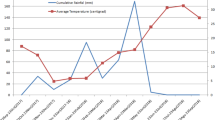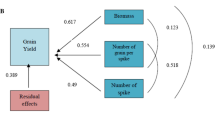Summary
One main reason for the slow improvement of durum wheat in water-limited environments is the lack of clear understanding of the interrelationships among yield components and their compensatory changes under low and erratic moisture availability. Five cultivars, varying in many physiological attributes, were tested under different drought-stress conditions in field and greenhouse experiments. The cause-effect relationships of duration of vegetative period, duration of grain-filling period, number of spikes per m2, kernels per spike, kernel weight and grain yield per m2 were assessed. Furthermore, yield stability was evaluated. Yield reduction was largest under mid-season stress (58%), followed by terminal stress (30%) and early stress (22%). Cultivar Po was very sensitive to terminal stress.
Path-coefficient analysis revealed a complex pattern of relationships among the six variables. An increase in vegetative period reduced the grain-filling period under all conditions. It increased number of kernels per spike under non-stress conditions. The direct effect of spikes per m2 on grain yield was significantly positive. However, more spikes per m2 resulted in fewer kernels per spike and a low kernel weight and, as a result, a negative relationship with grain yield under early stress. Grain-filling period had a strong influence on grain yield via kernel weight. Kernels per spike had the largest direct effect on grain yield. However, it was negatively correlated with kernel weight, especially under terminal stress. Grain yield heavily depended on kernels per spike under early stress and grain-filling period and kernels per spike under terminal stress.
Variation in drought susceptibility index among cultivars was significant under early and terminal stress conditions, but not under mid-stress conditions. Yield potential and stability were not correlated for the different drought-stress conditions.
Longer grain-filling period, increased number of kernels per spike and limited spike number per m2 can be used as selection criteria for sustainable yield in water-limited environments.
Similar content being viewed by others
References
Austin, R.B., C.L. Morgan, M.A. Ford & R.D. Blackwell, 1980. Contribution to grain yield from pre-anthesis assimilation in tall and dwarf barley phenotypes in two contrasting seasons. Annals of Botany 45: 309–319.
Blum, A., 1983. Genetic and physiological relationships in plant breeding for drought resistance. Agric. Water Mng. 7: 195–205.
Blum, A., 1988. Plant breeding for stress environments. CRC Press, Florida, 223 pp.
Blum, A. & Y. Pnuel, 1990. Physiological attributes associated with drought resistance of wheat cultivars in a Mediterranean environment. Aust. J. Agric. Res. 41: 799–810.
Blum, A., L. Sphiler, G. Golan & J. Mayer, 1989. Yield stability and canopy temperature of wheat genotypes under drought-stress. Field Crops Res. 22: 289–296.
Common, J.C. & H.R. Klink, 1981. Sequence and synchrony of culm development: implication in breeding for limited tillering barleys. p. 533–536. In: Barley Genetics IV. Proc. 4th Int. Barley Genet. Symp., Edinburgh, Scotland. Edinburgh Univ. Press.
Dofing, S.M. & M.J. Karlsson, 1993. Growth and development of uniculm and conventional-tillering barley lines. Agron. J. 85: 58–61.
Dofing, S.M. & C.W. Knight, 1992. Alternative model for path analysis of small-grain yield. Crop Sci. 32: 487–489.
Ehdaie, B., J.G. Waines & A.E. Hall, 1988. Differential responses of landrace and improved spring wheat genotypes to stress environments. Crop Sci. 28: 838–842.
FAO, 1984. Crop water requirement. FAO Bul. No. 24, pp. 15–30.
Fischer, R.A., 1985. Number of kernels in wheat crops and the influence of solar radiation and temperature. J. Agric. Sci. 105: 447–461.
Fischer, R.A. & R. Maurer, 1978. Drought resistance in spring wheat cultivars. I. Grain yield responses. Aust. J. Agric. Res. 29: 897–912.
Garcia del Moral, L.F., J.M. Ramos, M.B. Garcia del Moral & M.P. Jimenez-Tejada, 1991. Ontogenetic approach to grain production in spring barley based on path-coefficient analysis. Crop Sci. 31: 1179–1185.
Gebeyehou, G., D.R. Knott & B.J. Baker, 1982. Relationships among duration of vegetative and grain filling phases, yield components and grain yield in durum wheat cultivars. Crop Sci. 22: 287–290.
Hadjichristodoulou, A., 1985. The stability of the number of tillers of barley genotypes and its relation with consistency of performance under semi-arid conditions. Euphytica 34: 641–649.
Islam, T.M. & R.H. Sedgley, 1981. Evidence for a ‘uniculm effect’ in spring wheat (Triticum aestivum L.) in a Mediterranean environment. Euphytica 30: 277–283.
Li, C.C., 1956. The concept of path coefficient and its impact on population genetics. Biometrics 12: 190–210.
Nachit, M.M. & A. Ouassou, 1988. Association of yield potential, drought tolerance and stability of yield in Triticum turgidum var. durum. p. 867–870. In: Proceedings of the 7th International Wheat Genetics Symposium, Cambridge, UK, 10–13 July, 1988.
Simane, B. & P.C. Struik, 1993. Agroclimatic analysis; a tool for planning sustainable durum wheat (Triticum turgidum var. durum) production in Ethiopia. Agricultura, Ecosystems and Environment 47: 31–46.
Simane, B, H. Van Keulen, W. Stol & P.C. Struik, 1994. Application of crop growth model (SUCROS-87) to assess the effect of moisture stress on yield potential of durum wheat in Ethiopia. Agricultural Systems (in press).
Simane, B., J.M. Peacock & P.C. Struik, 1993. Differences in developmental plasticity and growth rate among drought resistant and susceptible genotypes of durum wheat (Triticum turgidum var. durum). Plant and Soil 157: 155–166.
Simane, B., P.C. Struik, R. Rabbinge & J.M. Peacock. Water use efficiency of durum wheat genotypes differing in drought resistance grown under different moisture regimes. Plant and Soil (submitted).
Slafer, G.A. & F.H. Andrade, 1991. Changes in physiological attributes of the dry matter economy of bread wheat (Triticum aestivum) through genetic improvement of grain yield potential at different regions of the world. Euphytica 58: 37–49.
Van Oosterom, E.J. & E. Acevedo, 1992. Adaptation of barley (Hordeum vulgare L.) to harsh Mediterranean environments. I. Morphological traits. Euphytica 62: 1–14.
Winter, S.R., J.T. Musick & K.B. Porter, 1988. Evaluation of screening techniques for breeding drought-resistant winter wheat. Crop Sci. 28: 512–516.
Author information
Authors and Affiliations
Rights and permissions
About this article
Cite this article
Simane, B., Struik, P.C., Nachit, M.M. et al. Ontogenetic analysis of yield components and yield stability of durum wheat in water-limited environments. Euphytica 71, 211–219 (1993). https://doi.org/10.1007/BF00040410
Received:
Accepted:
Issue Date:
DOI: https://doi.org/10.1007/BF00040410




